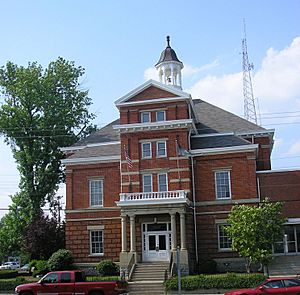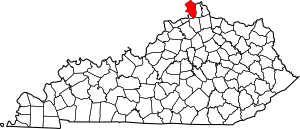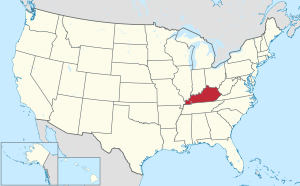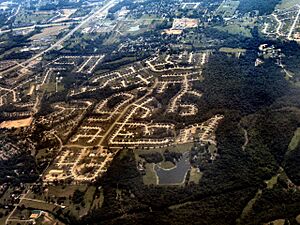Boone County, Kentucky facts for kids
Quick facts for kids
Boone County
|
|||||
|---|---|---|---|---|---|

The old Boone County courthouse in Burlington
|
|||||
|
|||||

Location within the U.S. state of Kentucky
|
|||||
 Kentucky's location within the U.S. |
|||||
| Country | |||||
| State | |||||
| Founded | 1798 | ||||
| Named for | Daniel Boone | ||||
| Seat | Burlington | ||||
| Largest city | Florence | ||||
| Area | |||||
| • Total | 256 sq mi (660 km2) | ||||
| • Land | 246 sq mi (640 km2) | ||||
| • Water | 10 sq mi (30 km2) 3.9%% | ||||
| Population
(2020)
|
|||||
| • Total | 135,968 | ||||
| • Estimate
(2023)
|
140,496 |
||||
| • Density | 531.1/sq mi (205.1/km2) | ||||
| Time zone | UTC−5 (Eastern) | ||||
| • Summer (DST) | UTC−4 (EDT) | ||||
| Congressional district | 4th | ||||
Boone County is a county located in the northern part of Kentucky. It sits right on the Ohio River. In 2020, over 135,000 people lived here, making it one of Kentucky's biggest counties.
The main town, or county seat, is Burlington. Boone County was created in 1798. It was named after the famous explorer and frontiersman, Daniel Boone. This county is part of the Northern Kentucky area and the larger Cincinnati metropolitan area. It is also home to the Cincinnati/Northern Kentucky International Airport, which serves many travelers in the region.
Contents
Discovering Boone County's Past
Boone County has a long and interesting history. Long ago, Native Americans lived here. They had a large village near what is now Petersburg. This village was used for hundreds of years, starting around 1150 A.D.
Early Explorers and Big Bones
In 1729, a French explorer drew a map showing an area in Boone County. He wrote that "they found the bones of an elephant" there. This place is now known as Big Bone Lick State Park. Later, another Frenchman, Charles le Moyne de Longueuil, explored this area more. They found many large, ancient animal bones, which made the area famous.
In 1789, a young boy named John Tanner was captured by Shawnee Native Americans in Boone County. This happened while his family was planting corn near the Great Miami River.
Boone County was officially formed in 1798. It was named to honor the brave frontiersman, Daniel Boone.
Margaret Garner's Story of Freedom
In 1856, a brave woman named Margaret Garner and her family escaped from slavery in Kentucky. They crossed the frozen Ohio River to reach Cincinnati, Ohio. Margaret wanted to protect her children from being forced back into slavery. Her story became very famous.
Margaret Garner's difficult journey inspired a well-known novel called Beloved. This book was written by Nobel Prize winner Toni Morrison. It was later made into a movie starring Oprah Winfrey. Margaret Garner's story also became an opera.
Boone County's Location and Neighbors
Boone County covers about 256 square miles. Most of this area is land, with about 10 square miles of water. Being located along the Ohio River was very important for the county's growth. The river was a major way to travel and transport goods in the early days.
Nearby Counties
Boone County shares its borders with several other counties:
- Hamilton County, Ohio (to the north)
- Kenton County (to the east)
- Grant County (to the south)
- Gallatin County (to the southwest)
- Switzerland County, Indiana (to the west)
- Ohio County, Indiana (to the west)
- Dearborn County, Indiana (to the northwest)
People of Boone County
| Historical population | |||
|---|---|---|---|
| Census | Pop. | %± | |
| 1800 | 1,534 | — | |
| 1810 | 3,608 | 135.2% | |
| 1820 | 6,542 | 81.3% | |
| 1830 | 9,075 | 38.7% | |
| 1840 | 10,034 | 10.6% | |
| 1850 | 11,185 | 11.5% | |
| 1860 | 11,196 | 0.1% | |
| 1870 | 10,696 | −4.5% | |
| 1880 | 11,996 | 12.2% | |
| 1890 | 12,246 | 2.1% | |
| 1900 | 11,170 | −8.8% | |
| 1910 | 9,420 | −15.7% | |
| 1920 | 9,572 | 1.6% | |
| 1930 | 9,595 | 0.2% | |
| 1940 | 10,820 | 12.8% | |
| 1950 | 13,015 | 20.3% | |
| 1960 | 21,940 | 68.6% | |
| 1970 | 32,812 | 49.6% | |
| 1980 | 45,842 | 39.7% | |
| 1990 | 57,589 | 25.6% | |
| 2000 | 85,991 | 49.3% | |
| 2010 | 118,811 | 38.2% | |
| 2020 | 135,968 | 14.4% | |
| 2023 (est.) | 140,496 | 18.3% | |
| U.S. Decennial Census 1790–1960 1900–1990 1990–2000 2010–2020 |
|||
In 2000, there were about 86,000 people living in Boone County. Many families live here, and about 40% of households have children under 18. The county's population has grown a lot over the years. The average age of people in Boone County was 33 years old in 2000.
Boone County's Economy
Boone County is an important place for business and travel. The Cincinnati/Northern Kentucky International Airport is located here. This airport is a major hub for flights and shipping. It is also where the company DHL Express has its main office.
Fun Places to Visit in Boone County
There are several interesting places to visit in Boone County:
- The Creation Museum in Petersburg teaches about the origins of the world from a specific viewpoint.
- Big Bone Lick State Park is known as the "birthplace of American paleontology". You can see where ancient animal bones were discovered.
- The Boone County Arboretum is a beautiful place to explore different kinds of trees and plants.
Learning in Boone County
Most students in Boone County attend schools within the Boone County Schools district. There is also a smaller school district called Walton-Verona Independent School District that serves some parts of the county.
Towns and Communities
Boone County has several cities and smaller communities.
Cities
Census-designated places
- Belleview
- Burlington (the county seat)
- Francisville
- Hebron
- Oakbrook
- Petersburg
- Rabbit Hash
- Verona
Other Unincorporated Communities
- Big Bone
- Bullittsville
- Hamilton
- Richwood
- Taylorsport
Boone County in a Book
In the novel The Disunited States of America by Harry Turtledove, Boone County is imagined as its own separate state!
See also
 In Spanish: Condado de Boone (Kentucky) para niños
In Spanish: Condado de Boone (Kentucky) para niños




